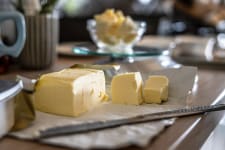To celebrate AAPI Heritage Month, the WAC content team talked with Guy Huynh, VP of Software Architecture at Wild Alaskan Company. Over the past four years, Guy’s been the digital powerhouse whose everyday work helps WAC evolve as a tech platform, one that supports a sustainable food system by connecting members across the U.S. with wild-caught fish from Alaska.
Guy’s experience coding, building behind-the-scenes infrastructure, and managing a team of engineers helps to provide WAC members with a seamless shipping experience, a responsive team of member experience specialists, and a website to house it all. Oh, and by the way, did I mention he’s a trained chef?
Guy talked to us about one of his favorite Vietnamese dishes from his youth, and what it was like to hone his cooking chops in culinary school and learn traditional Vietnamese flavors in his mom’s kitchen. His story of learning and resilience is full of family and flavor and the type of story that is best shared over food.
Guy’s interview with the WAC team has been edited for length and clarity.
***
You’ve shared a beautiful, flavorful recipe with us for a Vietnamese Sour Soup. What was your inspiration to share this recipe with WAC members?
Canh chua is a staple in Vietnamese households. It literally means sour soup and it brings together something spicy and something sweet at the same time. It’s usually made with a white fish or shrimp.
I love my mom’s canh chua. She’d make it at least once a week. She’d put in a lot of fresh vegetables, and she’d make it with tamarind paste. Now, as is the way of these things, I don’t often have tamarind so I make it with tomato or lemon juice. There can be any sour element present to give it the signature flavor.
What was it like to learn a recipe from your mom after being through the ringer in culinary school and in kitchens in Los Angeles and New York?
When I was growing up, I lived in a traditional Vietnamese household. The men didn’t do a lot of cooking, so my mother wouldn’t have traditionally taught her boys to cook. She was the matriarch, so she did the cooking.
Going to culinary school actually unlocked this experience for me. I had to grow up, become an adult, then go to culinary school before learning from my mom — then, she finally started to teach me. All of her directions were sensory, nothing was written down or measured. “Do this, look for this, taste this, make sure it’s that consistency.” My mom didn’t go to school. She learned to cook from her mom, and her mom before her.
It was fun to have her trust me in the kitchen and learn from her. Sometimes though, I did have to resist the urge to do something faster than her, like mincing onions or chopping vegetables.
What is your happiest memory involving food growing up?
Living in a Vietnamese household in Southern California, we would have all the family over and cook a massive feast. It was the thing I would look forward to most. All of the cousins, all of the aunts and uncles, would gather in someone’s house. These were usually two-bedroom apartments, so we’d eat on the living room floor, this massive spread on the carpet. My love of food really came from there. It was a regular thing in this Asian household, We didn’t need a special occasion. Those were some of the best memories.
You worked in technology before pivoting to culinary school. What drew you to culinary school after a career in tech?
I worked in technology for about 10 years, and then I burned out. I thought that tech was great, but after a company-wide layoff, it felt like a great opportunity to do something different. I truly have a love of food. All of the happy memories in my family revolve around food.
So, I went to culinary school, spent a few years in kitchens, then realized I couldn’t see myself doing it as a long-term career. I got back into the tech circuit, and brought what I learned with me, and worked my way back up from there.
For you, where do computer science and culinary arts intersect?
Cooking is procedural, but also creative. Coding has that same similarity. You have to make something, and make it correctly, but how you get there is also creative. The creativity, or the compromise is asking, When do you use the lemon juice instead of the tamarind? Sometimes I don’t have time to run to the store for tamarind.
Working in a professional kitchen teaches you that. On a slow day, you need to make the dish perfectly; you have all the time in the world. But when it’s a busy day, you make the dish, but make it as good as you can in the time that you have. That is like coding as well. When you have nothing else to do, make it perfectly, but when you’re in the weeds make it as good as you can.
***
Here’s to making memories with food, and bringing the traditions of our childhood, and our families, to our tables today. To that end, if you do try Guy’s Vietnamese Sour Soup, I hope you feel the love that went into the recipe.
Live Wild,
Monica
Pictured above: Guy (bottom right) pictured with his sister, mother, father, family friend, and cousins, sharing food on the floor of his family's Southern California apartment.






